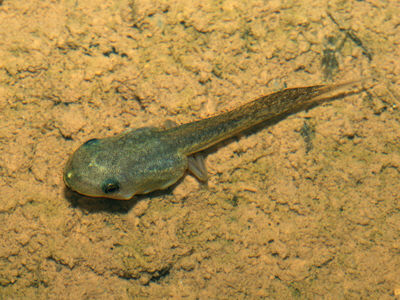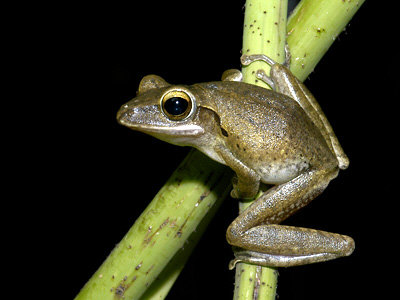
Fig 1

Fig 2

Fig 3

Fig 4

Fig 5

Fig 6

Fig 7
|
Family : RHACOPHORIDAE
Species : Polypedates leucomystax
Size (snout to vent) :
Female 7.5 cm, Male 5.5 cm
Play call
►
The Four-lined, or Common,
Tree Frog is a highly adaptable, arboreal species which occurs in a variety
of habitats including forest edge, agricultural clearings, wetlands, shallow
pools and semi-urban areas. It appears to be uncommon in deep, shaded
forest.
During rainstorms this frog is easily located by its distinctive call, which
is a loud, duck-like 'quack'.
It breeds at the margins of shallow pools, where it constructs a foam nest
on vegetation or rocks, which protects the fertilised eggs. The tadpoles
develop inside the foam nest, and either tumble into the pool below as they
grow bigger, or are washed into the pool during showers of rain. The
tadpoles are large (up to 3 cm), and may be identified by the presence of a pale spot at
the tip of the snout.
In Peninsular Malaysia and Singapore most specimens have a series of dark
stripes on their upper surface. In other territories, for example Java,
speckled or mottled forms appear to be dominant and in other areas, for
example Bali, plain forms are dominant.
The body shape of this frog is moderately slender (but sometimes robust in
large females), the head is of medium size, and the snout is pointed. As
with other frogs in the genus Polypedates, the hind feet are webbed
but the forefeet lack webbing.
Based on recent studies (Kuraishi et al, 2012), this species occurs
in parts of Myanmar, throughout southern Thailand, Peninsular Malaysia,
Singapore, Sumatra, Java, Borneo and Sulawesi, and parts of the Philippines.
North of the Isthmus of Kra (the narrowest part of the Thai peninsula) the
species is replaced in the rest of Thailand (and other countries of Indochina)
by the Brown Tree Frog Polypedates
megacephalus.
Fig 1 : Example from Yogyakarta, central Java, Indonesia: with a snout-vent
length of around 5 cm, this is probably a male.
Fig 2 : Mating pair from
Singapore: the male is considerably smaller than the female.
Fig 3 : Tadpole from Singapore. Note the white spot on the snout, which
helps to identify the species.
Fig 4 : Adult female with bold stripes, seen in a reed bed at Sedili, Johor, Peninsular Malaysia.
Fig 5 : Foam nest on a rocky boulder next to shallow pool in Singapore.
Fig 6 : Lightly speckled, yellowish-brown specimen from Phuket, southern Thailand.
Fig 7 : Large female specimen clinging to decorative woodwork, from
Yogyakarta, central Java, Indonesia.
References : H2, H3
Kuraishi, N., Matsui, M., Hamidy, A., Belabut, D. M., Ahmad, N., Panha, S.,
Sudin, A., Yong, H. S., Jiang, J-P., Ota, H., Ho, T. T. & Nishikawa, A.
(2013). Phylogenetic and taxonomic relationships of the Polypedates
leucomystax complex (Amphibia). Zoologica Scripta, 42(1), 54-70
|